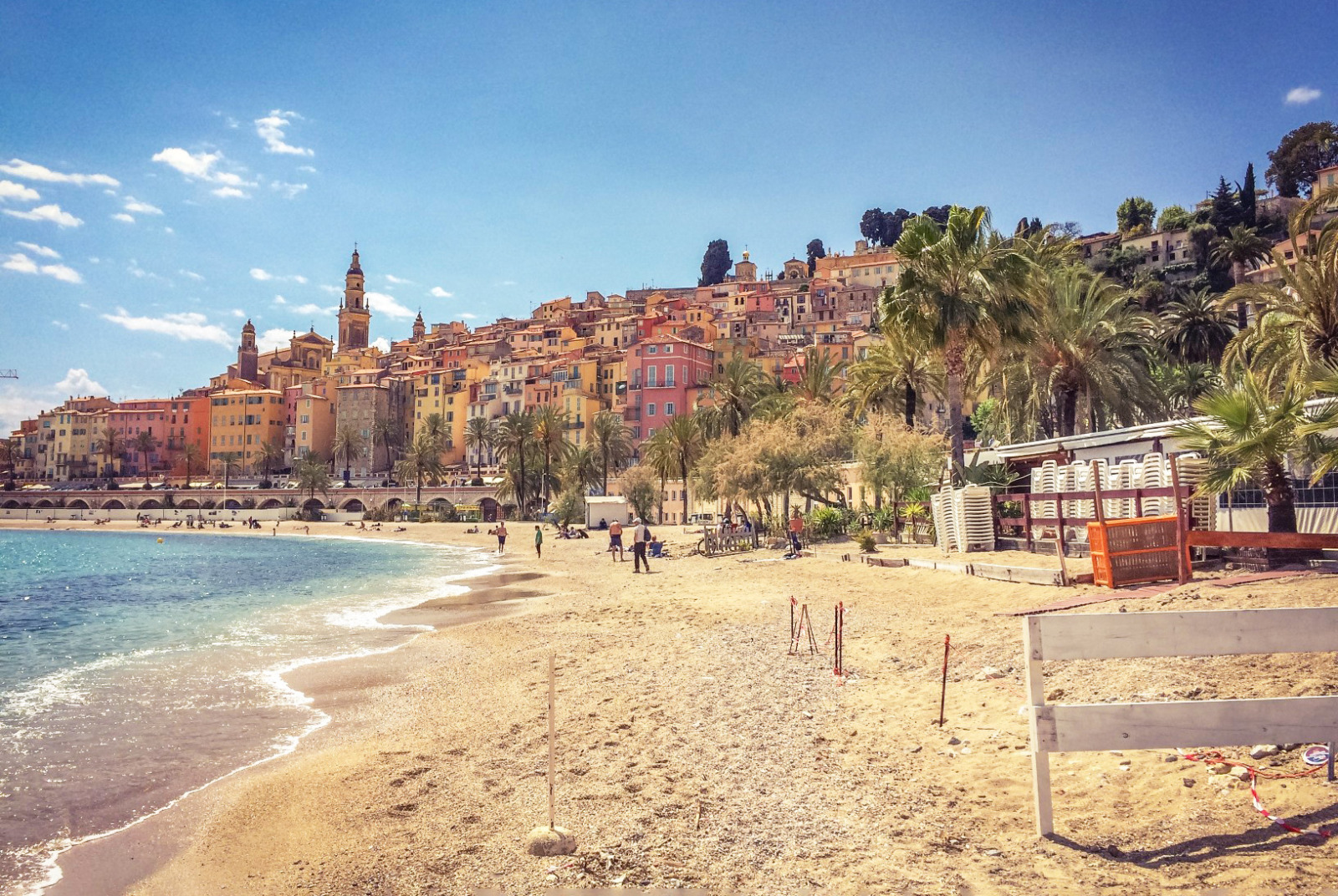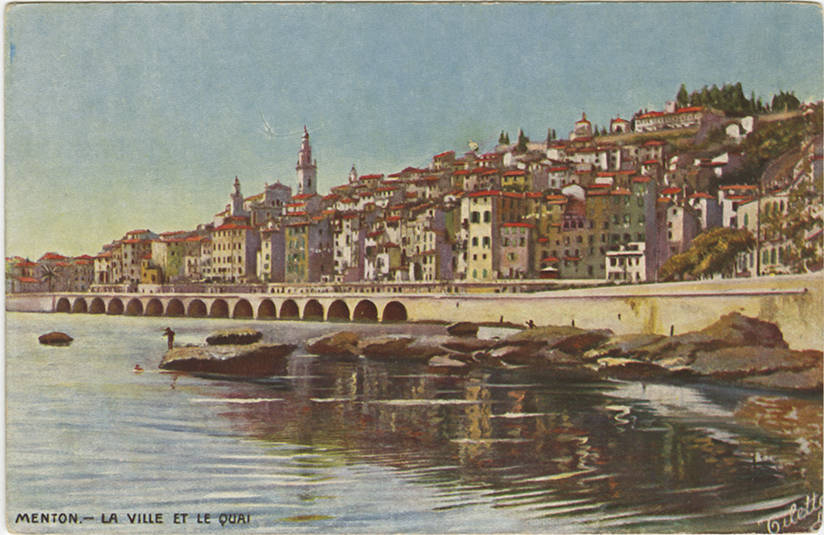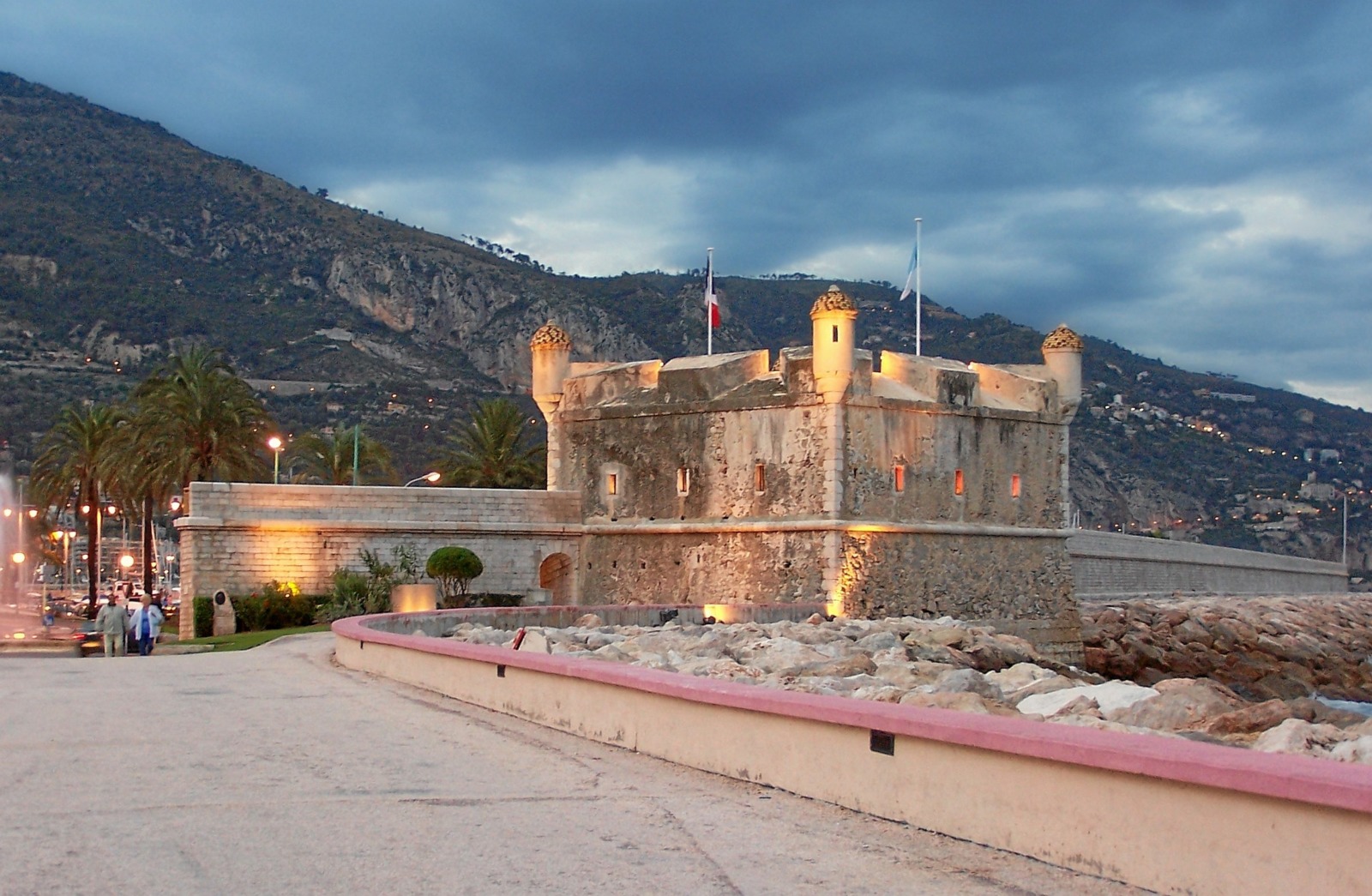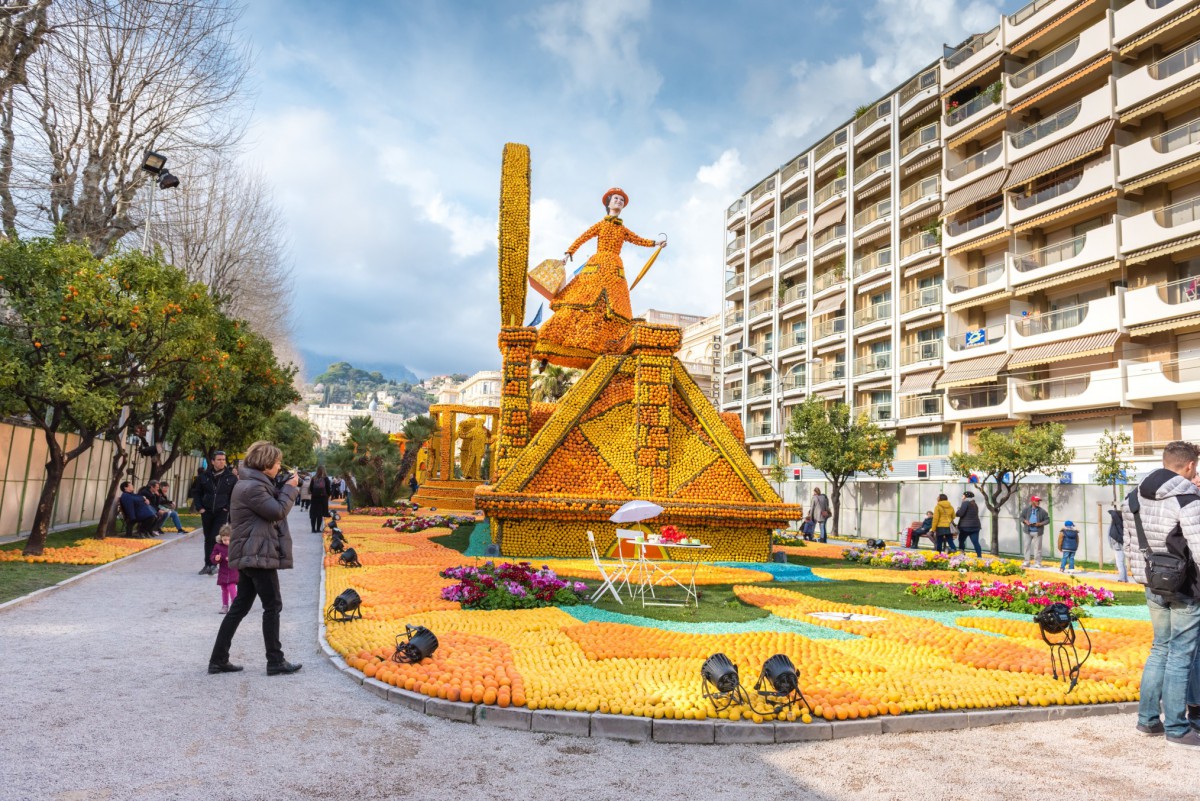The beauties of nature, the magnificence of the sun, the intoxication of the ever-changing sea… this was how Menton was described by English doctor James Henry Bennett, considered by the locals as the creator of the seaside resort. One of the prettiest towns on the French Mediterranean shores, sunny Menton is rightly nicknamed the “Pearl of France“. Set on the French-Italian border between the Italian Riviera and Monaco, Italianate Menton is the gateway to the glamorous French Riviera.
Plan your trip to Menton and the French Riviera!
- 🏨 Find the best accommodations in Menton on Booking.com
- 🙋♀️ Get the PASS CÔTE D’AZUR and take your pick from more than 100 amazing experiences!
- 🌴 Visit the parks and gardens of Menton
- 🎯 Take a guided hidden gem tour of Monaco
- 🥗 Experience the culture and food of Old Nice on a 4-hour sightseeing and tasting tour
- 📚 Read the DK Eyewitness Provence and the Côte d’Azur Travel Guide
- 🤩 Get familiar with the French Riviera

What you should know about Menton
Menton is situated on the French Riviera along the Franco-Italian border, 30 km from Nice and 170 km from Genoa (Italy).

The closest Italian town is Ventimiglia (Vintimille in French).
Fun fact! The longest distance in mainland France as the crow flies is from Menton to the Saint-Laurent peninsula in Brittany: 1,084 km / 673 miles. By road, you will have to travel 1,500 km / 932 miles!
![Menton from above © Olivier Cleynen - licence [CC BY 4.0] from Wikimedia Commons](https://frenchmoments.eu/wp-content/uploads/2014/08/Menton-from-above-©-Olivier-Cleynen-licence-CC-BY-4.0-from-Wikimedia-Commons.jpg)
The local micro-climate
Menton enjoys an exceptional near-subtropical micro-climate with mild winters and hot summers due to the protection of the Alps. This climatic condition is favourable to the culture of citrus fruit, which explains why Menton used to be Europe’s biggest lemon producer until the 1930s.

Minimum temperatures in winter are usually no less than 8 degrees Celsius and a maximum of 28 in summer.
The touristic districts of Menton
The town of Menton comprises three touristic sectors:
The modern city
To the west, the modern city stretches out on either side of the Biovès Gardens. This is where the SNCF train station is located.
Rue de la République and Avenue Félix Faure, which becomes Rue Saint-Michel, are the two main roads of the modern town, where most of the shops are located. This part of the city opens onto the bay of the sun.
The old town
In the centre, the old town whose old houses follow the relief of the hill. The rue Saint-Michel and the rue Longue follow the route of the ancient Roman road.
To the north of the Basilica of Saint-Michel, a labyrinth of winding streets runs along the slope of the hill: rue du Vieux Château, rue de la Côte, rue Mattoni.
The cemetery occupies the top of the hill, from where there is a magnificent view of the Baie du Soleil (west) and Baie de Garavan (east).
Saint-Paul Garavan
To the east, the Saint-Paul Garavan district is notable for the villas and gardens that make it up. It overlooks the bay of Garavan. The Port of Garavan (inaugurated in 1967) is considered one of the largest ports on the French Riviera with 770 berths.

The seaside
Finally, the seaside is crossed by a road axis taking, in turn, different names: the promenade du Soleil, the quai de Monléon, the quai Bonaparte, Porte de France and promenade de la Reine Astrid which ends at the customs.
Menton’s Parks and Gardens
The town boasts many reputed parks and gardens from intimate parks to exuberant or botanical gardens.

Read my dedicated article on Menton’s Parks and Gardens. You will discover 8 not-to-miss amazing sites!
The Lemon Tart of Menton
A classic lemon tart (tarte au citron) has a wonderful balance of lemons and a crispy sweet base. Tart enough to tingle on the tongue and delight your senses!

Find out more about the recipe of the Lemon Tart.
Famous People of Menton

The commune of Menton has a population of approximately 30,000 (75,000 with the suburbs), and its people are either called Mentonnais and Mentonnaises, or more traditionally Mentonasques.
Famous residents include:
- Englishman William Webb Ellis (1806-1872) creator of rugby football,
- British Baptist preacher Charles H. Spurgeon (1834-1892) who died in Menton,
- Jean Cocteau (1889-1963) a French poet, novelist, dramatist, designer, playwright, artist and filmmaker,
- American singer Barbara Hendricks (Citizen of Honour, was married in Menton),
- French goalkeeper Jérôme Alonzo (b. 1972)…
Menton: a bit of history
It is believed that the site of Menton was already inhabited during the Paleolithic era.

The Roman road
During Roman times, the site of Menton was crossed by the Via Julia Augusta. The Roman way run from Pisa, Italy to Arelates (present-day Arles, France). It crossed Menton’s neighbouring Italian town Album Intimilium (modern Ventimiglia) and La Turbie where the Romans built a monument (Trophy of Augustus) to celebrate emperor Augustus’ victory over the Ligurian tribes.

In the Middle Ages
The first written mention of Menton dates back to 21 July 1262 at the occasion of a peace treaty between the City of Genoa and Charles of Anjou, King of Sicily and Naples as well as Count of Provence. The position of Menton between the Republic of Genoa and the County of Provence was highly coveted during the Middle Ages.

In 1346, the town was acquired by Charles Grimaldi of Monaco and stayed under the possession of the Grimaldis until 1848. That year, Menton and the neighbouring town of Roquebrune seceded from Monaco in response to litigation involving taxes on lemon exports. The two towns self-proclaimed a ‘Free City’ and placed themselves under the protection of the King of Sardinia.
The Maritime Alps département
Menton was then administrated by the House of Savoy until 1861 when the town voted massively for its annexation to France by referendum (833 for versus 54 against). Nice and its county had taken a similar decision a year before and Menton was added to the département of Alpes-Maritimes. In February 1861, Napoleon III paid to the prince of Monaco 4 million francs to compensate for the renouncement of the lord’s rights in perpetuity.
Menton had become French for a limited time during the French Revolution and the First Empire and was included in the newly created département of Alpes Maritimes. During a few years, the town was part of the Sanremo arrondissement, now in Italy.

A trendy winter holiday destination of the 19th century
In the second half of the 19th century, Menton encountered a deep change following the publication of a treatise by James Henry Bennett: Winter and Spring on the Shores of the Mediterranean (1861) praising the mild climate of the town to tuberculosis sufferers.
The English doctor had contracted the infectious disease and found himself completely healed after a stay in Menton in 1859. It was believed that his health had greatly improved thanks to winters in mild weather at the French Riviera.
By his writings, the doctor contributed to popularising Menton and its surroundings as an upper-class winter holiday destination.
English and Russian aristocrats built their luxurious hotels, villas, and palaces which are now part of the townscape of Menton which would be transformed into hospitals during the First World War to welcome injured soldiers. In 1882, there were 5,000 British residents living in Menton.

Some of Bennett’s famous patients included Robert Louis Stevenson and more notably Queen Victoria and her youngest daughter, Princess Beatrice.

From the annexation to France until the outbreak of the First World War, Menton continued its urban development. The construction of the harbour was completed in 1878 and new communication links made the town easier to reach:
- the Lower Corniche Road (1881) and
- the railway link between Monaco and Menton which opened in 1869.
Back then, the train journey from Paris to Menton “only” took 24 hours.
Menton in the 20th and 21st centuries
From summer 1940 to 8 September 1943, Italy annexed Menton. Then the Germans replaced them until 6 September 1944. The American and Canadian armies of the First Special Service Force freed the town on 8 September 1944.

Since the 1950s, Menton has engaged in a twinning programme with many prestigious towns in Europe:
- Baden-Baden (Germany),
- Montreux (Switzerland),
- Namur (Belgium),
- Nauplie (Greece),
- Noordwijk (The Netherlands),
- Sochi (Russia), and
- Valencia (Spain).
In 1964 a memorable scene of French blockbuster “Le Corniaud” (‘the Sucker’) starring Louis de Funès and Bourvil was filmed at the border checkpoint of Menton. In 1983, the James Bond movie “Never Say Never Again” with Sean Connery featured the old town.
It is important to note that throughout its history, Menton has never been part of the historic County of Nice.

The old town of Menton
Octave Mirbeau (1848-1917) put it nicely when describing Menton:
“Old Menton with its steep tiers of houses huddled one on top of the other, its mysterious myriad of rippling patches of light and dark, its sudden flashes of sun and of blue church towers, all projected against the velvet opalescence of the mountains.”

The campanile of St. Michel Church proudly soars above the steep narrow lanes and pastel-shaded façades of the historic old town, squeezed between two bays.

La rampe Saint-Michel
From the seafront, a succession of majestic flight of steps leads up to the cobbled parvis of the church. Locals call them la rampe Saint-Michel.
To the right of the stairs is the yellow-façade of the Hôtel Pretti (or hôtel Pretti de Saint-Ambroise) which dates to the mid-17th century.

![Rampes Saint Michel © Bastenbas - licence [CC BY-SA 4.0] from Wikimedia Commons](https://frenchmoments.eu/wp-content/uploads/2014/08/Menton-Rampes-Saint-Michel-©-Bastenbas-licence-CC-BY-SA-4.0-from-Wikimedia-Commons.jpg)
St-Michel-Archange Basilica

Prince Honoré II of Monaco had the Saint-Michel-Archange Basilica built between 1639 and 1653 in Baroque architecture. The church was consecrated by Mauro Promontorio, bishop of Ventimiglia, on 8 May 1675 in the presence of Prince Louis I of Monaco.
The iconic 53-metre tall bell tower is a later addition (1701) by architect Emmanuel Cantone. It makes the church the tallest structure in town.

Completion of the yellow and pale green façade dates to 1819. It features a Baroque style typical of the 17th century with added columns topped with ionic and corinthian capitals.
The inside of the church is laid out as a Latin cross and was inspired by the Annunziata Basilica in Genoa.
![Inside the Saint-Michel basilica in Menton © Espirat - licence [CC BY-SA 4.0] from Wikimedia Commons](https://frenchmoments.eu/wp-content/uploads/2014/08/Menton-Basilique-Saint-Michel-©-Espirat-licence-CC-BY-SA-4.0-from-Wikimedia-Commons.jpg)
The decoration is unsurprisingly sumptuous and the side chapels contain the tombs of local and Monaco notables. The church welcomes more than 100,000 visitors each year.
Chapelle des Pénitents Blancs

Next to the basilica stands another Baroque church: the Chapelle des Pénitents Blancs (or Chapelle de l’Immaculée-Conception).
Its construction took place from 1680 to 1687 and the church underwent an important restoration in the 19th century. Its façade displays several Baroque decorations: pinnacles, friezes, and garlands of stucco flowers. Three theological virtues surmount the pediment.
Chapelle de la Miséricorde des Pénitents Noirs
At the crossroads of the rue de Bréa and the promenade du Val de Menton, the chapel of the Miséricorde des Pénitents Noirs was the sanctuary of the former 17th century Capuchin convent.


Old streets of Menton, French Riviera
The French ministry of culture labelled Menton as a ‘Ville d’art et d’histoire’. A general view of the historic part of Menton from the seafront gives the appearance of a perched village.

The ochre façades of tall houses border the narrow streets of the old town which are often dark, winding and vaulted. They are linked by covered passages or reach cool little squares.


![Menton © Patafisik - licence [CC BY-SA 4.0] from Wikimedia Commons](https://frenchmoments.eu/wp-content/uploads/2014/08/Menton-©-Patafisik-licence-CC-BY-SA-4.0-from-Wikimedia-Commons.jpg)
Rue Mattoni is a narrow street that starts from the church square (see the archway). It runs through a maze of tall houses north of the St Michel church.
![The entrance to the old town of Menton © Luca Galli - licence [CC BY 2.0] from Wikimedia Commons](https://frenchmoments.eu/wp-content/uploads/2014/08/Menton-Old-Town-©-Luca-Galli-licence-CC-BY-2.0-from-Wikimedia-Commons.jpg)
The Vieux-Château cemetery

At the very top of the old town lies the Vieux Château cemetery. It commands a magnificent site and dominates the town, the old port and the bay of Garavan.

It is home to the Russian cemetery of Menton, an Orthodox cemetery built in 1880 for the Russian colony.
Access is through the small Russian chapel Notre-Dame-des-Affligés, dating from the 1880s. It is quadrangular in shape, topped by a small dome, with a facade distantly reminiscent of the entrance to the Russian Orthodox Cathedral of St Nicholas in Nice. It serves as the mausoleum of the Trubetskoy princes.
![The Vieux-Château cemetery and the Russian chapel © Renek78 - licence [CC BY-SA 4.0] from Wikimedia Commons](https://frenchmoments.eu/wp-content/uploads/2014/08/Menton-Cimetière-du-Vieux-Château-and-Russian-Chapel-©-Renek78-licence-CC-BY-SA-4.0-from-Wikimedia-Commons.jpg)
Families of White Russian descendants have also been buried here since 1917.
Palais de l’Europe
The Palace of Europe is the town’s former casino.
![Palais de l'Europe © Berthold Werner - licence [CC BY-SA 3.0] from Wikimedia Commons](https://frenchmoments.eu/wp-content/uploads/2014/08/Menton-Palais-de-lEurope-©-Berthold-Werner-licence-CC-BY-SA-3.0-from-Wikimedia-Commons.jpg)
Architect Hans-Georg Tersling built it in 1909 with an imposing façade, making it one of the most important buildings in the city centre. It now houses the Tourist Board of Menton.
It borders the famous Biovès Gardens where part of the Lemon festival takes place.
The seafront of Menton, French Riviera
![Menton © Claire2595 - licence [CC BY-SA 3.0] from Wikimedia Commons](https://frenchmoments.eu/wp-content/uploads/2014/08/Menton-©-Claire2595-licence-CC-BY-SA-3.0-from-Wikimedia-Commons.jpg)
The palm-lined seafront of Menton features some beautiful green spaces, museums, as well as free pebble beaches, private sandy beaches and two marinas. Longing the seafront, the 16 giant arches of Quai Napoleon marks the limit of the old town.
The Bastion of Menton
The princes of Monaco built the fort in 1636 to protect Menton’s harbour.

Jean Cocteau (1889-1963) a multitalented French poet, novelist, dramatist, designer, playwright, artist and filmmaker, had this monument restored in order to house a permanent exhibition for his work: drawings, tapestries, watercolours, pastels and ceramics.
The Jean Cocteau Museum

You will find the Jean Cocteau Museum between the beach and the covered market. Since its opening in 2011, the museum has displayed drawings, tapestries and mosaics by Jean Cocteau.
Séverin Wunderman donated to the municipality of Menton his collection of some 1,500 artefacts.
The beaches of Menton
![Plage des Sablettes. Photo: Tangopaso [Public Domain]](https://frenchmoments.eu/wp-content/uploads/2014/08/Menton-Plage-des-Sablettes-by-Tangopaso-Public-Domain.jpg)
Menton is famous for its beaches. There are 6 main ones:
- Hawaii. It is the first beach in France when you arrive from Italy. It is relatively small and often exposed to the swell. Its waves are great fun for children.
- Rondelli. You’ll find this fine sandy beach in the Garavan district, near the supermarket.
- Les Sablettes. Before 1969 it was a very small sandy beach. It was artificially extended between 1968 and 1969. The beach, located at the foot of the old town, is protected from swells and easterly winds by three dikes.
- Marché (or Bastion). This beach is close to the old covered market and the new Jean Cocteau Museum.
- Casino. As its name suggests, this beach is just behind the casino of Menton.
- Borrigo. The beach is next to the Casino.
Town Events

Menton is famous in France for its Lemon Festival which takes place every February.
The Menton Chamber Music Festival takes place every year on the parvis of St. Michel Basilica.
Where to stay in Menton
If you wish to visit Menton and the French Riviera, it is important to choose the location of your base carefully, so as not to travel unnecessary distances each day. After all, the coastline stretches over several hundred kilometres… and the location of Menton on the French-Italian border allows for great excursions along the Italian Riviera.
![Menton French Riviera General View © MOSSOT - licence [CC BY-SA 3.0] from Wikimedia Commons](https://frenchmoments.eu/wp-content/uploads/2014/02/Menton-French-Riviera-General-View-©-MOSSOT-licence-CC-BY-SA-3.0-from-Wikimedia-Commons.jpg)
As you can guess, the accommodation possibilities in Menton are very vast.
There is bound to be an accommodation for every desire:
- Are you looking for a palace with a view of the sea?
- A charming bed and breakfast in the heart of a hilltop village?
- A villa surrounded by greenery?
- A comfortable campsite?
- Or one of the most unusual accommodations?
Find your accommodation here or browse the map below:
What to do in Menton

There is a multitude of activities to do on the Côte d’Azur.
You will be spoilt for choice:
- panoramic helicopter flights,
- museums in Nice and Monaco,
- guided tours of the hilltop villages,
- Ferrari/Lamborghini driving,
- jet skiing,
- cruises between Monaco and Nice,
- perfume workshops in Grasse…
Oui, the sky is the limit!
To help you get an idea, here is a list of some activities in the region of the French Rivera proposed by GetYourGuide.
You can click on each element to find out more about what is on offer as there are much more activities to discover on the GetYourGuide website.
How to get there
Thanks to its proximity to Nice, it is easy to reach Menton either by air, train or car.

By air
Nice airport (France’s 3rd after Paris-CDG and Paris-Orly) has flights from London and many British cities (Birmingham, Liverpool, Leeds, Edinburgh). A bus connects the airport to Nice railway station where half-hourly trains to Menton only take 30 minutes.
By car
Menton is situated on the A8 motorway which links Aix-en-Provence to the Italian border and Genoa via the A10. The distance from Paris is 960 km and the journey takes approximately 9 hrs via the Autoroute du Soleil (A6, A7 and A8).
By train
The railway station of Menton is within 5 minutes walking distance from the seafront. Menton is linked to Nice by TER from where TGV and long-distance trains reach the main cities of France: Paris (7 hrs), Marseille (3.30 hrs), Lyon (5.30 hrs), Bordeaux (9 hrs), Lille (12 hrs), Strasbourg…
![Menton Railway Station. Photo: Tangopaso [Public Domain]](https://frenchmoments.eu/wp-content/uploads/2014/08/Menton-Railway-Station-by-Tangopaso-Publid-Domain.jpg)
Pin it for later!


Find out more!
- Our discovery guide of the French Riviera
- Take part in the famous Lemon Festival
- Have a stroll in the Parks and Gardens of Menton
- All there is to know about the Principality of Monaco
- Follow the Corniche Roads of the Riviera from Nice to Menton
- Read this article in French on our blog Mon Grand-Est
- The Wikipedia article on Menton
- The Tourist Office Board of Provence-Alpes-Côte d’Azur
- Visit the official website of Menton’s Tourist Board
Have you been to Menton? If so, what is your favourite place? Leave me a comment just below!
French Riviera: English-French Vocabulary
(f) for féminin, (m) for masculin, (adj) for adjective and (v) for verbs
- Alps = Alpes (f,p)
- annexation = annexion (f)
- Baroque art = art baroque (m)
- basilica = basilique (f)
- beach = plage (f)
- border = frontière (f)
- campanile = campanile (m)
- chapel = chapelle (f)
- citrus fruit = agrume (m)
- French Riviera = Côte d’Azur (f)
- Genoa = Gênes
- House of Savoy = Maison de Savoie (f)
- Italy = Italie (f)
- lemon = citron (m)
- lemon tart = tarte au citron (f)
- marina = port de plaisance (m)
- Mediterranean Sea = Mer Méditerranée (f)
- micro-climate = micro-climat (m)
- museum = musée (m)
- park = parc (m)
- Pearl of France = Perle de la France (f)
- perched village = village perché (m)
- railway = chemin de fer (m)
- seafront = bord de mer (m)
- sun = soleil (m)
- Ventimiglia = Vintimille
Featured image: © Vinbaron – licence [CC BY-SA 3.0] from Wikimedia Commons

![Menton on the French Riviera. Photo by Vinbaron - licence [CC BY-SA 3.0] from Wikimedia Commons](https://frenchmoments.eu/wp-content/uploads/2014/08/Menton-French-Riviera-Provence-by-Vinbaron-licence-CC-BY-SA-3.0-from-Wikimedia-Commons.jpg)



Pierre, thank you for this wonderful view of Menton. These towns are just beautiful and full of history and culture. Just another visit for my bucket list!
Oh merci beaucoup Ellen, c’est très gentil ! Yes Menton is a must-see destination when visiting the French Riviera… and a great place to savour delicious lemon pies 😉